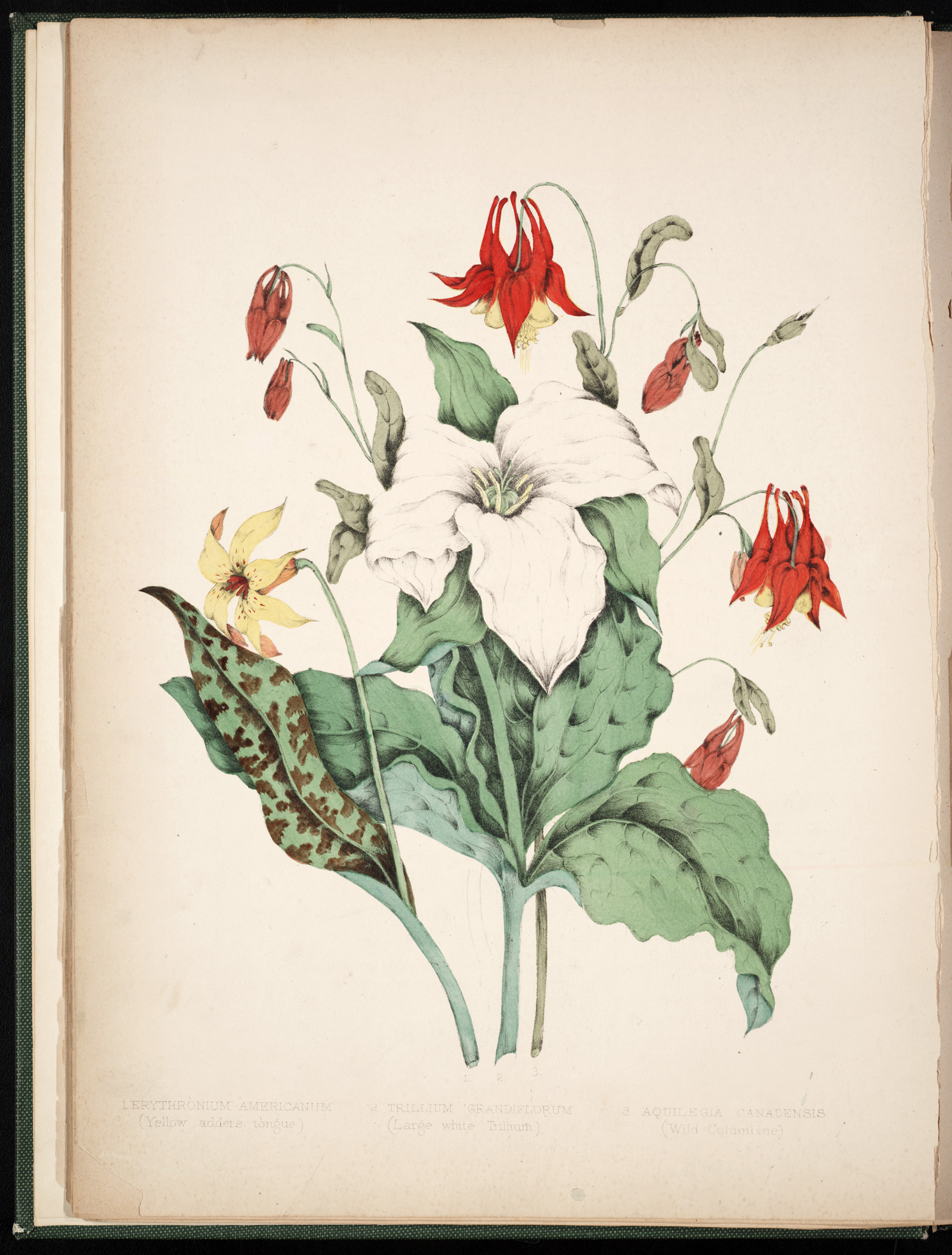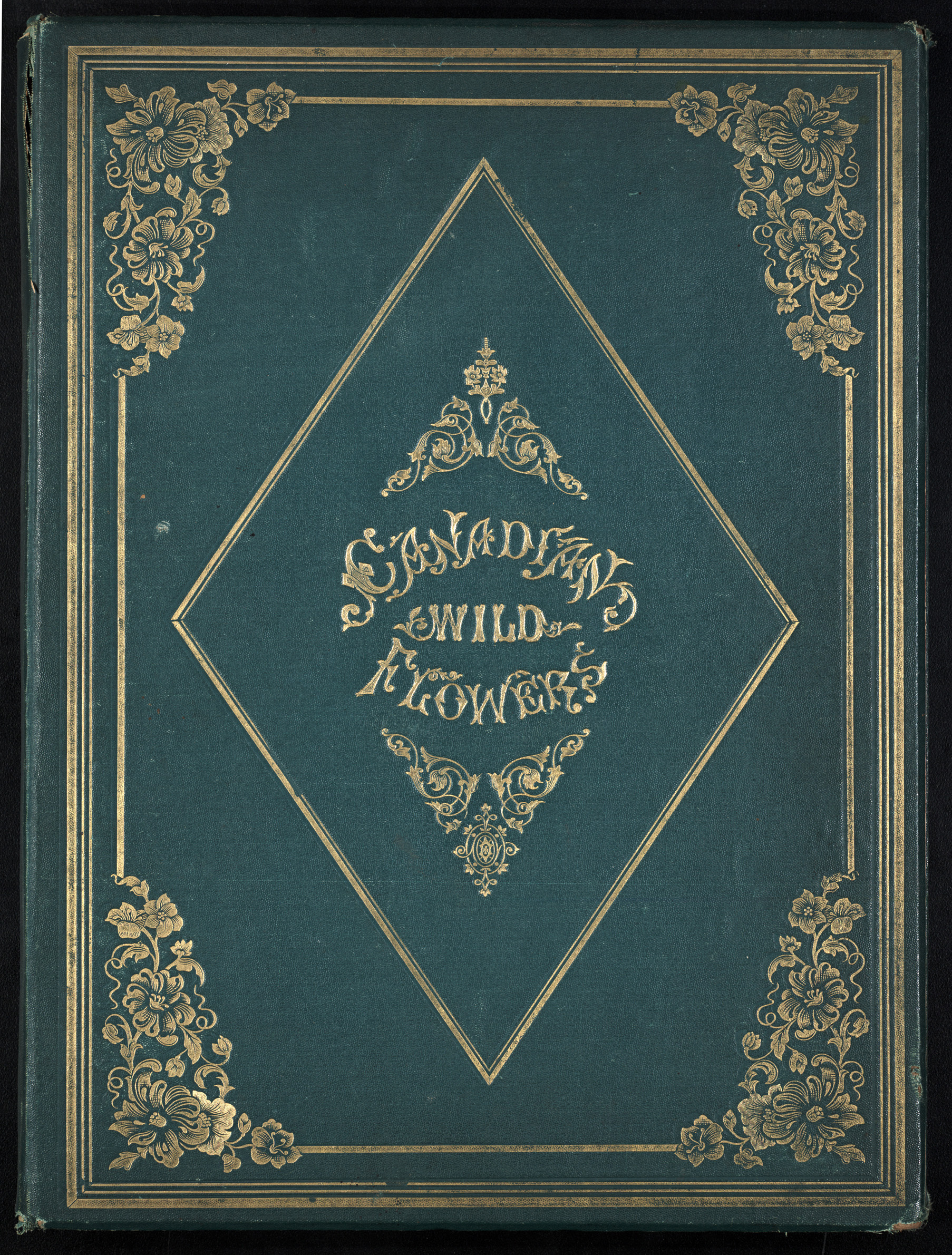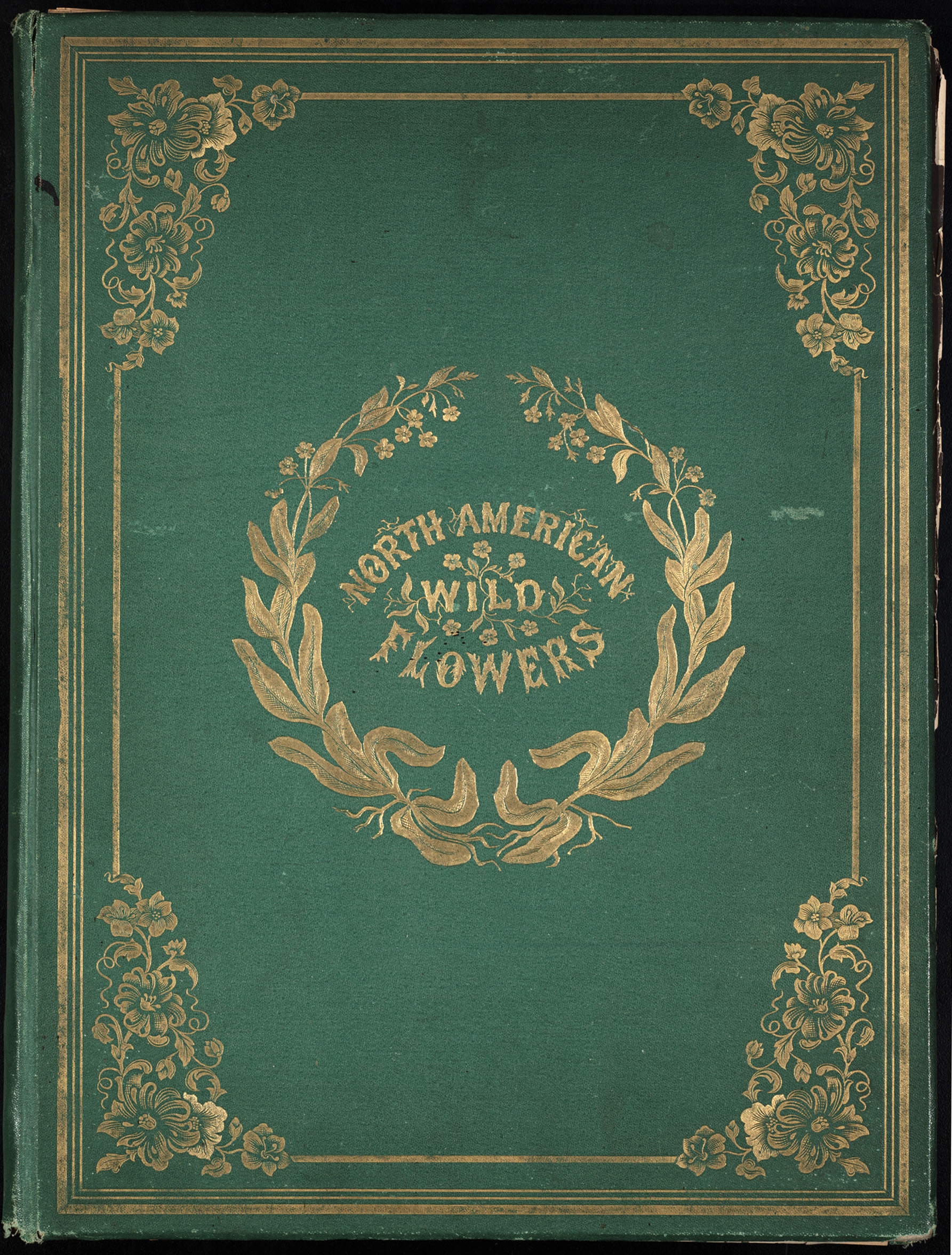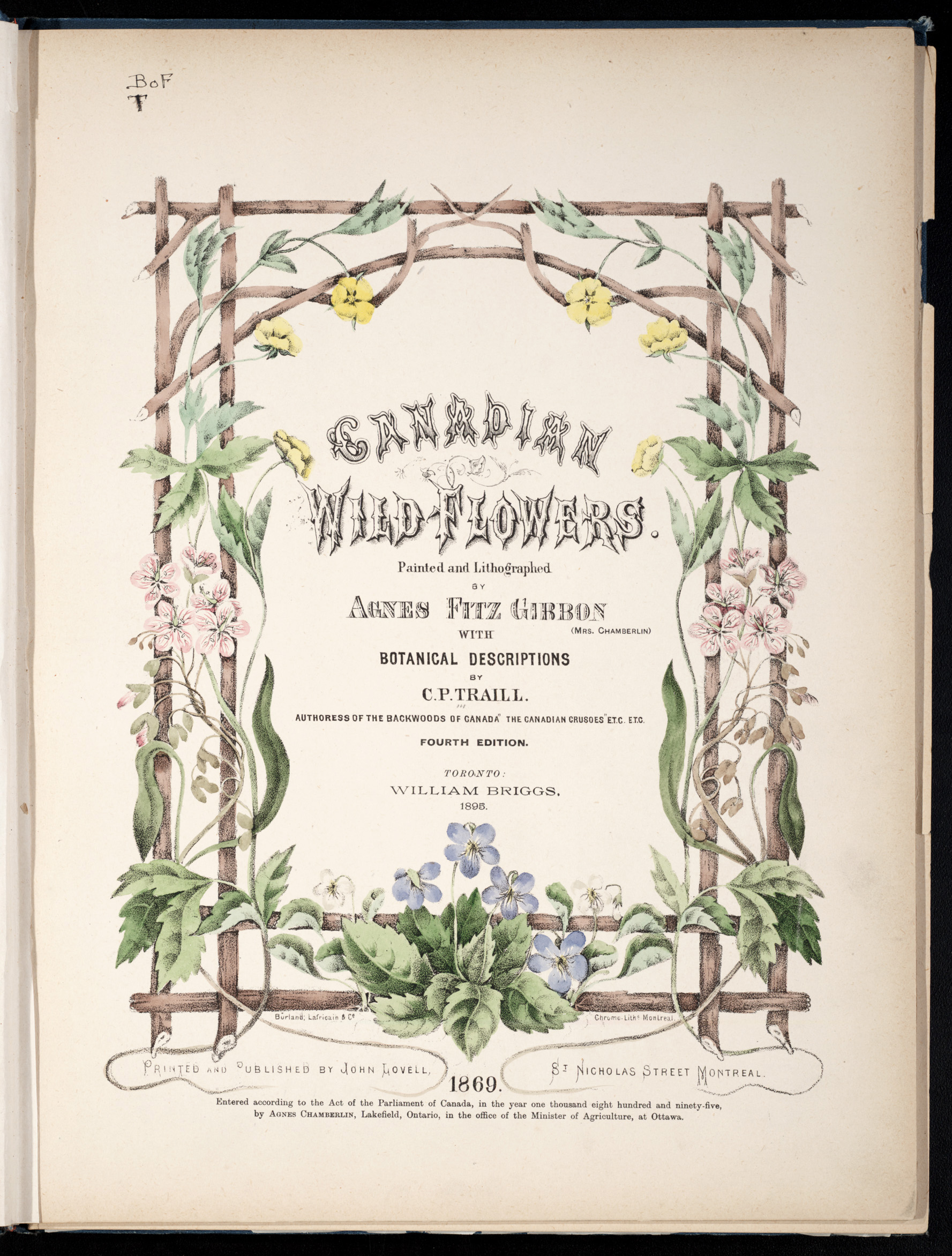The Story of Canadian Wild Flowers
Alexander Globe
Canadian Wild Flowers is prized for Agnes FitzGibbon’s splendid illustrations, which evoke Ontario woodlands and meadows. In 1894, biologist James Fletcher justly praised Traill’s plant descriptions as “one of the greatest botanical triumphs.” She also wrote with breath-taking panache, celebrating endangered habitats. After one of the few accurate nineteenth-century descriptions of the rose species Rosa lucida (now called Rosa carolina), she comments: “This beautiful red-barked rose grows in great profusion on the huckleberry plains above Rice Lake, clothing large tracts of hill and dale, and scenting the evening air at dew-fall with its delicate fragrance.”
Catharine Parr Traill, née Strickland (1802-99) enjoyed her doting father’s botanical excursions and published Sketch Book of a Young Naturalist in 1831. In 1832, she and her newlywed husband Thomas Traill left genteel England to homestead near Peterborough, Ontario. The hardships broke Thomas her husband, who died in 1859. By 1861 Catharine Catharine Parr Traill had written a groundbreaking work on hundreds of local plants. Despite commendations by professors, no Toronto firm was willing to risk publishing a long, specialized book in a city of only 45,000.
Traill asked her niece to supply illustrations to improve chances of publication. Agnes FitzGibbon (1833-1913), daughter of the famed author Susanna Moodie, née Strickland (1803-85), had moved to Toronto after marrying barrister Charles FitzGibbon in 1850.  When he died in February 1865, Agnes decided to help her aunt, hoping that the work would help support her six children. John Lovell of Montreal had published works by both the Strickland sisters in his literary periodical, The Literary Garland. In November 1866, he calculated the costs of producing Traill’s botanical volume. The authors had to supply the illustrations and enlist 500 subscribers. In order to recover costs, the book would have to be priced at the hefty sum of $5, which at that time was enough to buy a substantial piece of furniture. In February 1867, Lovell sent FitzGibbon an impressive sales dummy in a green cover with two illustrations and specimen text. By 20 June 1867, she had recruited over 400 subscribers, as described in more detail in the case study, “Agnes FitzGibbon’s Subscription Books for Canadian Wild Flowers.”
When he died in February 1865, Agnes decided to help her aunt, hoping that the work would help support her six children. John Lovell of Montreal had published works by both the Strickland sisters in his literary periodical, The Literary Garland. In November 1866, he calculated the costs of producing Traill’s botanical volume. The authors had to supply the illustrations and enlist 500 subscribers. In order to recover costs, the book would have to be priced at the hefty sum of $5, which at that time was enough to buy a substantial piece of furniture. In February 1867, Lovell sent FitzGibbon an impressive sales dummy in a green cover with two illustrations and specimen text. By 20 June 1867, she had recruited over 400 subscribers, as described in more detail in the case study, “Agnes FitzGibbon’s Subscription Books for Canadian Wild Flowers.”
 FitzGibbon took over the project, paying her aunt $50 for the text. After painting and lithography lessons, she drew the title and ten floral designs, one after the other, on the same borrowed stone. The Toronto firm William Chewett printed the lithographs. At home through much of 1867-68, she painted 5,000 sheets in 16 opaque colours, aided by her three daughters and two young women from a Toronto painting school for ladies operated by the wife of artist Hoppner Meyer. Meanwhile Traill wrote complementary text, finishing with the preface in December 1868. The first edition, bound in green or reddish-brown cloth, had an uncoloured 1868 title, 86 pages of text, and ten plates. It appeared in January 1869 and sold out by March.
FitzGibbon took over the project, paying her aunt $50 for the text. After painting and lithography lessons, she drew the title and ten floral designs, one after the other, on the same borrowed stone. The Toronto firm William Chewett printed the lithographs. At home through much of 1867-68, she painted 5,000 sheets in 16 opaque colours, aided by her three daughters and two young women from a Toronto painting school for ladies operated by the wife of artist Hoppner Meyer. Meanwhile Traill wrote complementary text, finishing with the preface in December 1868. The first edition, bound in green or reddish-brown cloth, had an uncoloured 1868 title, 86 pages of text, and ten plates. It appeared in January 1869 and sold out by March.
 FitzGibbon had already collected hundreds of new names by the end of 1868. Lovell responded with a second edition dated 1869 in a more luxurious binding. The artist created and paid for eleven new stones at Burland L’Africain Chromolithographers, Montreal. She hoped the higher cost of $6 per copy plus postage would result in actual profit. The plates were numbered I-X, and the designs of II, III, IV, V, VI, and VII were reversed for aesthetic reasons. FitzGibbon painted 5,500 more sheets with transparent washes; stencils sped the pace of the work.
FitzGibbon had already collected hundreds of new names by the end of 1868. Lovell responded with a second edition dated 1869 in a more luxurious binding. The artist created and paid for eleven new stones at Burland L’Africain Chromolithographers, Montreal. She hoped the higher cost of $6 per copy plus postage would result in actual profit. The plates were numbered I-X, and the designs of II, III, IV, V, VI, and VII were reversed for aesthetic reasons. FitzGibbon painted 5,500 more sheets with transparent washes; stencils sped the pace of the work.
In early 1870, she was canvassing more subscribers in Montreal and Ottawa. In response, Lovell produced a third edition with reset type extended to 88 pages. The authors reordered the plants by seasonal bloom, though the plates were not renumbered. Early spring was moved to the beginning, with PLATE X facing p. [9]. Late spring, then summer followed on plates III, IV, II, VI, V, VII, VIII, and IX. PLATE I, mixing spring with late summer blooms, ended the volume.
 The third edition was issued in 1870, though the date 1869 remains on most copies of the title-plate. The Canadian Wild Flowers issue has five variants. A second issue, North American Wild Flowers, was prepared for an American business Lovell was developing at Rouse’s Point, New York. Agnes FitzGibbon married Brown Chamberlin, the Queen’s Printer, on 14 June 1870 and moved to Ottawa. Domestic responsibilities, including the birth of a daughter on 7 April 1871, left no time for further work on Canadian Wild Flowers. In 1885, she was instrumental in having her aunt’s full botanical manuscript published by A.S. Woodburn of Ottawa as Studies of Plant Life in Canada.
The third edition was issued in 1870, though the date 1869 remains on most copies of the title-plate. The Canadian Wild Flowers issue has five variants. A second issue, North American Wild Flowers, was prepared for an American business Lovell was developing at Rouse’s Point, New York. Agnes FitzGibbon married Brown Chamberlin, the Queen’s Printer, on 14 June 1870 and moved to Ottawa. Domestic responsibilities, including the birth of a daughter on 7 April 1871, left no time for further work on Canadian Wild Flowers. In 1885, she was instrumental in having her aunt’s full botanical manuscript published by A.S. Woodburn of Ottawa as Studies of Plant Life in Canada.
 William Briggs prepared a numbered fourth edition of Canadian Wild Flowers in Toronto, 1895. Agnes painted more plates, printed from the 1869 stones, which she had stored in Ottawa. Following typical Briggs practices, she paid for the letterpress and accepted a commission on books the firm sold. The title-plate assigns copyright to “Agnes Chamberlin, Lakefield, Ontario.” On 25 February 1896, a copy establishing colonial copyright was deposited in the library of the British Museum (now the British Library). About 121 copies were sold, most signed 1895 on a maroon limitation page. Copies 111 (University of Waterloo) and 121 (Oxford University) have 1903 as the date of issue. Chamberlin sold additional “colourist’s” copies privately from Lakefield with uncoloured plates and small slips describing the plant colours tipped in opposite them. The page 8 preface is dated 1895. Protecting sales of the limited edition, Briggs insisted on a simple black and white reprint of the 1869 title-plate, which has confused owners ever since.
William Briggs prepared a numbered fourth edition of Canadian Wild Flowers in Toronto, 1895. Agnes painted more plates, printed from the 1869 stones, which she had stored in Ottawa. Following typical Briggs practices, she paid for the letterpress and accepted a commission on books the firm sold. The title-plate assigns copyright to “Agnes Chamberlin, Lakefield, Ontario.” On 25 February 1896, a copy establishing colonial copyright was deposited in the library of the British Museum (now the British Library). About 121 copies were sold, most signed 1895 on a maroon limitation page. Copies 111 (University of Waterloo) and 121 (Oxford University) have 1903 as the date of issue. Chamberlin sold additional “colourist’s” copies privately from Lakefield with uncoloured plates and small slips describing the plant colours tipped in opposite them. The page 8 preface is dated 1895. Protecting sales of the limited edition, Briggs insisted on a simple black and white reprint of the 1869 title-plate, which has confused owners ever since.
In addition to housing the subscription books for Canadian Wild Flowers and the first two editions of the book itself, the Chamberlin Collection at the Thomas Fisher Rare Book Library at the University of Toronto, includes over 300 original paintings by Agnes FitzGibbon, including many executed for Canadian Wild Flowers and are featured in an online digital collection.
Gray, Charlotte. Sisters in the Wilderness: The Lives of Susanna Moodie and Catharine Parr Traill. Toronto: Viking, 1999.
Moodie, Susanna. Letters of a Lifetime, ed. Carl Ballstadt, Elizabeth Hopkins, and Michael A. Peterman. University of Toronto Press, 1985.
Peterman, Michael A. Sisters in Two Worlds: A Visual Biography of Susanna Moodie and Catharine Parr Traill. Toronto: Doubleday Canada, 2007.
Traill, Catharine Parr. I Bless You in My Heart: Selected Correspondence, ed. Carl Ballstadt, Elizabeth Hopkins, and Michael A. Peterman. University of Toronto Press, 1996.
Traill Family Collection, National Archives of Canada
http://www.collectionscanada.gc.ca/moodie-traill/027013-1200.7-e.html
Agnes Dunbar (Moodie) Chamberlin Papers, Thomas Fisher Rare Book Library, University of Toronto


![Poster; McClelland & Stewart, “Celebrating 100 Years”, [January 2006]](/sites/default/files/styles/thumbnail/public/canpub/CP01170.jpg?itok=VFtvtfaa)
![Letter from [John McClelland] (McClelland, Goodchild & Stewart) to F.D. Goodchild, 24 July 1918](/sites/default/files/styles/thumbnail/public/canpub/CP01171.jpg?itok=vGpXwXus)
![Letter from [John McClelland] (McClelland, Goodchild & Stewart) to F.D. Goodchild, 24 July 1918](/sites/default/files/styles/thumbnail/public/canpub/CP01171-002.jpg?itok=rd162nB9)
![Photograph of McClelland & Stewart staff, [197-]](/sites/default/files/styles/thumbnail/public/canpub/CP01172.jpg?itok=9Cg1vg7_)









